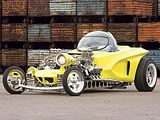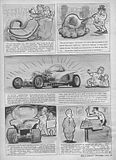Two ca. 400 hp, 406 cu. in. Ford V8 engines, two three-speed automatic transmissions, live axle front suspension with coil springs, live axle rear suspension with coil springs, two-wheel hydraulic drum brakes.
Mysterion was Roth’s fourth custom, built in 1963 and featured in full color on the cover of the September 1963 Rod & Custom magazine, in other magazines and even in a “how-to” book for aspiring custom builders. By this time Roth was well-established as the creator of the custom tee-shirt, using his cars to draw crowds where he and his staff could sell them shirts custom air brushed on the spot. The shirts – featuring Rat Fink and other outrageous and vaguely disgusting inhabitants of Roth’s world– had made Roth a personality. They became the emblem of a rebellious youth and gave Roth the financial freedom to do pretty much as he wanted.
He wanted to build cars but Roth didn’t want to build just any cars, or even any hot rods. It took fantastic cars, conceived and built outside the mold of convention to satisfy Roth.
Outlaw (1959) and Beatnik Bandit (1960) had set the pattern and established Roth’s “Big Daddy” persona in concert with Revell models. Revell re-created Roth’s rods in plastic, a material which took its name from its inherent characteristic of being able to assume pretty much any shape. And “plastic” suited Roth’s free-form thinking.
Another plastic material, fiberglass, gave Roth the freedom to mold his ideas in full size and with sufficient strength to stand the rigors of being driven and displayed. He devised the “spitwad” method of modeling, a term he coined with characteristic disdain for conventional niceties. It involved large quantities of soggy newspaper and plaster which were built up, formed and smoothed into the shape he saw in his mind’s eye, then covered in fiberglass before being chipped, chiseled and gouged away to leave the body. It was labor intensive but effective and it suited the fantastic shapes that existed only in Roth’s mind, shapes that couldn’t be pulled from conventional molds or layup forms.
Outlaw was identifiable as a T-bucket. Beatnik Bandit was a more complete vision, but Mysterion broke the mold. The front was asymmetrical with a single pedestal mounted headlight shaded within the eyebrow bezel of a Plymouth Sport Fury flanked by a pair of ’49-’51 Ford marker lights. Set off near the right front wheel was a single 4 1/2-inch Harley-Davidson spotlight. Suspension had four sprint car like links locating a stretched Ford axle suspended on coil springs.
Power came from a pair of canted 406 Ford V8s like the multi-engined dragsters made famous by TV Tommy Ivo. There was a pair of Cruise-o-Matic automatic transmissions, two driveshafts and a custom-made rear axle with two Ford center sections. It also had four link coil spring rear suspension, custom front wheels and a bubble canopy that raised hydraulically. What wasn’t chromed (and that was pretty much everything that wasn’t fiberglass) was painted black. Built on a pair of deep c-section frame rails with huge round lightening cutouts to break their slab sides, it was outrageous.
After Roth finished Mysterion, he traded it to Bob Laravee of Promotions, Inc. before it eventually would up in Ray Fahrner’s shop. Jack Walker ended up with the body, one frame rail and a nose, which he then gave to a friend in 1971. This friend in turn passed those pieces to someone in Tulsa, Oklahoma, but they have never resurfaced. The original Roth creation was therefore pieced out, lost to history and evaporated into the hot rod and custom ethereal, with Roth himself receiving the engines back. |






|




